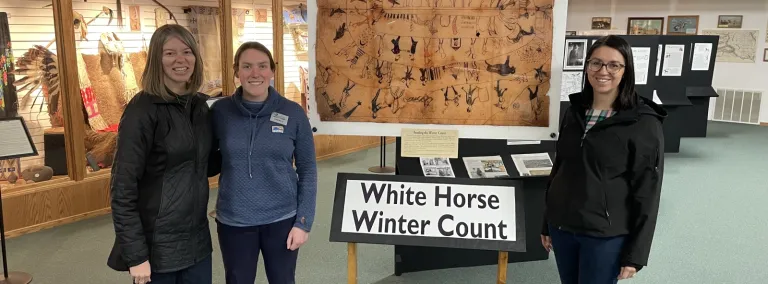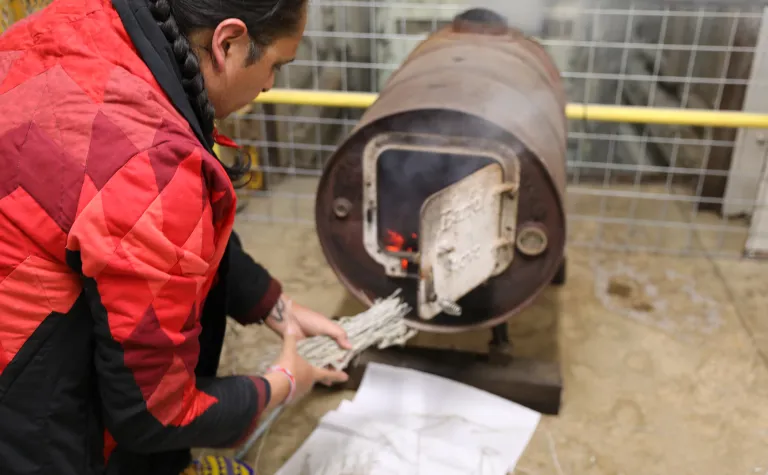Star Knowledge Working Group at SURF builds connections to improve understanding of past solar eclipses and astronomical events
The group at the SURF works to bring together traditional indigenous understandings of the universe with astronomers and astrophysicists.
Knowledge comes from multiple different world views, and the Star Knowledge Working Group at the Sanford Underground Research Facility (SURF) brings together traditional indigenous understandings of the universe with the work of astronomers and astrophysicists at SURF. The group is an extension of a longstanding effort at SURF to build bridges with Native American communities who hold the Black Hills sacred.
Winter Counts are one of many powerful examples of Lakota star knowledge. These pictographs are written histories on buffalo hides and muslins. They often record astronomic and other historic events, including previous solar eclipses, and a previous pass of the Pons-Brooks Comet, which is also visible with a telescope at the same time as the 2024 solar eclipse.
Some astronomical events recorded on Lakota Winter Counts include:
-1822: A large booming meteorite, that could have been a meteor air burst similar to the Chelyabinsk Meteor which exploded in the atmosphere above Russia in 2013.
-1834: Was recorded across many separate winter counts as, “The year of stars moving in the sky.” This was likely the massive Leonid meteor shower recorded around the world in November of 1833. The event lit up the sky with up to 67 meteors every second. “The sky would have seemed absolutely alive,” said Mark Hanhardt, an astrophysicist and experiment support scientist at SURF who is part of the Star Knowledge Working Group.
-Most notably the White Horse Winter Count likely recorded the 12P/Pons-Brooks Comet that was visible to the naked eye in late 1883 or early 1884. This comet will also be visible via telescope in the path of the total solar eclipse of 2024 in North America. “This is a periodic comet that returns to the inner solar system every 71 years. That means it was here in 1884, 1954, and 2024. It's here right now,” Hanhardt said. “I'm fairly certain the White Horse Winter Count describes the 12P/Pons-Brooks comet, the same 71-year-cycle comet that will be visible via telescope during the 2024 eclipse.”
The Star Knowledge Working Group recently traveled to the Timber Lake Museum on Wakpa Wasté Oyanke, also known as the Good River or Cheyenne River Reservation, to speak with museum staff on the White Horse Winter Count. A photo of this winter count is on display at the Sanford Lab Homestake Visitor Center.
Rochelle Zens (Sičháŋǧu Lakȟóta) works in the outreach and culture department at SURF and says these historic records and the Lakota understanding of the universe are valuable to science.
"The evidence is in the winter counts. Lakota people and other indigenous groups recorded astronomical events that sometimes went unrecorded by Western scientists. Winter counts and other indigenous records of history offer a new perspective, additional data, to Western scientists across a variety of disciplines,” Zens says.
The bridges being built in the Star Knowledge Working Group aim to drive a deeper understanding of both traditional indigenous knowledge and modern science. Hanhardt notes that from an astrophysics perspective, the solar eclipses we view from Earth are rare events not just on the planet, but also in the solar system.
“Even though there are about 293 moons in our solar system, Earth is the only place that has a perfectly sized moon orbiting at the perfect distance to perfectly cover the Sun as viewed from the (solid) surface of the planet,” says Hanhardt. “Every other planet in the solar system either has no moons, incorrectly sized moons, or no meaningful surface to stand on to watch the eclipse.”
Hanhardt adds that since the moon gets about 1 ½ inches farther away from Earth every year, in about 600 million years (which is a long time to humans, but a blink of an eye for the universe), we won't always be able to experience solar eclipses. “We live in a very privileged place and time in the universe to be able to witness this incredible piece of the cosmic dance,” added Hanhardt.
All of human history has been witness to this “cosmic dance.” Even today, events like the 2024 solar eclipse, elicit a collective marvel and wonder that forms the foundation for both scientific inquiry and indigenous oral history and storytelling. Research at SURF seeks to answer some fundamental questions about the makeup of the universe, and the parallel wisdom, stories, and recorded history of indigenous people adds to the depth of this pursuit.



